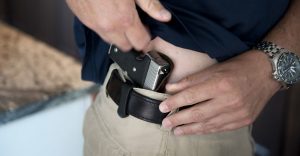
By Charles Heller – May 2022 AZCDL Newsletter
Universities are tasked with giving students their “skill set” to be successful. They teach important career subjects, and how to apply rational judgment and critical thinking skills, such as using comparison and analysis. Lets do this with campus carry:
Has the LAWFUL presence of firearms at schools, served to reduce violence?
Yes, at Pearl, Mississippi in 1997, where Assistant Principle Joel Myrick, detained 16-year-old murderer Luke Woodham, at gun point: http://en.wikipedia.org/wiki/ Pearl_High_School_shooting .
It worked at the Appalachian Law School shooting in 2002, where students Mikael Gross and Tracy Bridges helped detain murderer Peter Odighizuwa at gun point: http://www.thepriceofliberty.org/04/01/13/ lang.htm
It worked in 2008, when attacker Alaa Abu Dhein was shot by a part-time student, Yitzhak Dadon, allowing IDF soldier Captain David Shapira enough time to finish neutralizing the threat, with his personal sidearm, carried off duty: http:// en.wikipedia.org/wiki/Mercaz_HaRav_ massacre.
Has the LAWFUL carry of firearms on a campus caused any problems?
Since the fall semester of 2006, state law in Utah has allowed licensed individuals to carry concealed handguns on the campuses of all public colleges. Concealed carry has been allowed for several years at both Colorado State University in Fort Collins, CO and Blue Ridge Community College in Weyers Cave, VA. This has yet to result in a single act of violence at any of these schools. Numerous studies*, and various state agencies, show that concealed weapon permit holders are five times less likely than non-license holders to be arrested for violent crimes.
Will the police protect the students?
Testimony before the Arizona Legislature by the police Chief of ASU, said that, “Our response time is usually about 4 minutes to any location on campus.”
The police were not able to protect the victims at Virginia Tech, Columbine, U of A, or NIU. When seconds count, the police are minutes away.
The courts have consistently ruled that the police do not have an obligation to protect individuals. In 1982, in Bowers v. Devito a federal court of appeals said: “There is no constitutional right to be protected by the state against being murdered by criminals and madmen.” (686 F.2d 616, at 618)
Will the police be able to tell the shooter from the defender when they arrive?
Contrary to what the movies might have us believe, most real-world shootouts last less than ten seconds**. It is unlikely that an exchange of gunfire between an armed assailant and an armed citizen would last more than a couple of seconds before one or both parties were disabled. If the assailant were disabled, he would be unable to do any more harm.
When arriving officers order the CCW permit holder to drop the gun, he does. The violent criminal actor often does not. That is a problem that the police are well equipped to solve.
There is simply no real down side to letting 21-year-old CCW permit holders, carry concealed weapons on campus.
*“Crime, Deterrence, and Right-to-Carry Concealed Handguns,” John Lott and David Mustard, Journal of Legal Studies (v.26, no.1, pages 1-68, January 1997); “An Analysis of the Arrest Rate of Texas Concealed Handgun License Holders as Compared to the Arrest Rate of the Entire Texas Population,” William E. Sturdevant, September 1, 2000; Florida Department of Justice statistics, 1998; Florida Department of State, “Concealed Weapons/Firearms License Statistical Report,” 1998; Texas Department of Public Safety and the U.S. Census Bureau, reported in San Antonio Express-News, September 2000; Texas Department of Corrections data, 1996-2000, compiled by the Texas State Rifle Association.
**In The Line of Fire: Violence Against Law Enforcement, U.S. Department of Justice, Federal Bureau of Investigation, National Institute of Justice, 1997
Charles Heller AzCDL Communications Coordinator and host of America Armed & Free Radio, AM 1030 KVOI, Tucson

Nice article